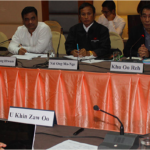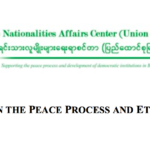By Sai Wansai / Shan Herald Agency for News (SHAN) | August 8, 2016
Aung San Suu Kyi’s position has been that Panglong Agreement is not important enough but it’s spirit is the propelling factor that has facilitated the making of the Union of Burma and the achievement of independence from the British in 1948.
She had on two occasions, when meeting with the Nationwide Ceasefire Agreement (NCA) signatory Ethnic Armed Organizations (EAOs) in June and as well the non-signatory EAOs of United Nationalities Federal Council (UNFC) in July, reiterated her position to this line of thinking, which is worrying for the whole spectrum of politically aware ethnic nationalities and straight-thinking Bamar politicians.
What has she actually said on this issue? Let us have a close look at it.
According to the transcript published in SHAN on 4 August, on the occasion of the meeting between the UNFC and Aung San Suu Kyi, on 17 July in Rangoon, Suu Kyi elaborated on Panglong as follows:
“(The question of) whether Panglong convention is to be based on the Panglong Agreement or the Panglong Spirit is too general and not exact. (If we) reread it, the main point is only concerned with the Kachin. In comparison to other ethnic nationalities, paragraph 5, 6 and 9 mentioned exactly only the Kachin. Paragraph 8 mentioned the Shan. In mentioning the Shan it was very general. For example, in paragraph 8: The arrangements accepted in this Agreement are without prejudice to the financial autonomy now vested in the Federated Shan States. Therefore, the word without prejudice could be interpreted in a lot of ways. So, even if we were to go according to the Panglong Agreement, we would be in a condition that we could do a lot of more or less adjustment. This couldn’t be a problem for us, if we would like to achieve agreement. My mentioning of Panglong Spirit is meant to (emphasize) unity. But I said we must take (endorse) the spirit, for (in the agreement) only Shan, Kachin, Chin and Bamar were included. Mon, Kayah (Karenni) and a lot were not included. That’s why I said to base (the solution) on Panglong Spirit. It is impossible to base on Panglong Agreement, where only Kachin, Chin, Bamar and Shan (are involved). In addition, it is not meant to limit the rights of the ethnic nationalities by not saying (agreeing) accordingly to the Panglong Agreement, but expressively for it is too narrow. To build genuine federal union, we need a more wider scope.”
Her argument is that because of the unity to strive together – Burma Proper, Federated Shan States, Kachin and Chin Hills – for independence, it was achieved and thus the spirit born at the Panglong town is more important than the agreement itself.
Another justification is that since the Karenni, Mon, Karen and Arakan among others were not represented, the agreement is narrow in scope and must be widened, implying that the treaty be cast aside and replace it with a new and more comprehensive one.
Earlier, while she was meeting with the 8 signatory EAOs in Naypyitaw, on 28 June, she literally said: “Questions have been asked, if Panglong convention is meant to address the agreement or the spirit. First of all, it is not only the Panglong Agreement. I want to say it is not the main point. Because at that time, Panglong Agreement was signed due to the necessity to achieve independence. As all ethnic signatories know, only a few (ethnic nationalities) were included and the excluded ones could ask whether they are left abandoned, if we base (the federal union deliberations) only on the Panglong Agreement.”
This argument has irked quite a lot of people and some even interpreted as a contradiction to her late father Aung San – Suu Kyi’s late father assassinated on the eve of independence in 1947 -, who was the main protagonist and representative of the Bamar interim government in the historical signing of Panglong Agreement in 1947.
Let us scrutinize these two said arguments of Suu Kyi on whether they are relevant and logical enough.
For the first one, the importance of the unity to achieve independence from the British is a valid argument. But it has to be taken into account with a pinch of salt, that a strong degree of doubtfulness were at all time present during the negotiations, and also the angst that the Bamar would just take over the mantle of the British and overwhelmed them as a new ruler, which has actually proven to be the case, judging from what had happened and has been happening, starting from the time of independence from the British until now.
The secession clause included in the 1947 Union of Burma constitution is a living evidence on how far had the Bamar representative Aung San had gone to woo the ethnic nationalities and alleviate their worries.
Thus the unity achieved in Panglong in 1947 is not a wholesale doubtfulness free unity that Suu Kyi likes to portray but realpolik at play and a calculated risk involved, from the part of the ethnic nationalities, which turned out to be a wrong decision.
As for the second argument that the other ethnic groups were not included and thus is not comprehensive enough is also not totally true. For Burma Proper or Ministerial Burma as it was then known and represented by Aung San as it’s interim government covered all the territories inhabited by Mon, Karen, Arakan and all the others, safe for the Karenni State that was then recognized as an independent political entity by the British. Thus in an official and legal sense, the portion of Burma Proper and all the ethnic groups inhabiting it were all represented by Aung San at the Panglong conference and the agreement signed thereafter.
Vice-President Naw Zipporah Sein, who represented the Karen National Union (KNU) at Mai Ja Yang EAOs’ Plenary Meeting from 26 to 30 July, in reply to the query from Karen Information Center (KIC) recently said that the party has agreed, together with all the other ethnic nationalities, regarding Panglong Handbook guidelines. She stressed: “Panglong is directly concerned with large ethnic nationalities like Shan, Kachin and Chin. For the other ethnic nationalities, the Panglong Spirit of rights to self-determination, democracy and equality in building a federal union are included.”
Further, she concluded that the points from the Panglong Agreement is identical with the formation of a federal union and thus, the KNU is in agreement with it.
Seen from this light, the possible argument that this agreement made in 1947 should be nullified and replace it with a new one is uncalled for and in no way a sound approach.
It is a treaty between ethnic groups and states and has to be treated as such. Downgrading and belittling the treaty won’t do any good in trying to achieve national reconciliation.
The argument that out of the nine points in the treaty some of it consisted only the Kachin and Shan issues and were vaguely written is not a sound one, especially in view of disregarding the agreement altogether.
True, part of the agreement also mentioned the immediate remedy of the day, where the Kachin State formation and arrangement concerning Shan State’s financial matters were concerned. And fair enough to argue that it is not comprehensive enough, with a far-reaching solution effect that could remedy the woes of present political reality.
But the important point is the part of agreement on autonomy in internal administration, the financial autonomy, democracy and equality, which would lead to the creation of a federal union.
And what is essential is that the Panglong Agreement be treated as a treaty between ethnic groups and continue to build on the sound agreement made and not disregarding or belittling it.
Aung Htoo a renowned lawyer and a keen Burma watcher recently said: “Firstly, there should be only one agreement in the structuring (building) of the union. For example, the 1945 United Nation Charter, 1291 Switzerland’s Federal Charter and 1963 Malaysia Agreement, all until today have only one agreement.”
He stressed that in building a society there should be only one solid treaty or agreement and won’t be logical to draw up another new one. He also pointed out: “If we were to draw up a new agreement in the second Panglong convention – meaning the 21st Century Panglong Agreement – , question will arise if we are going to disregard the first one – 1947 Panglong Agreement.”
His argument is that if the first Panglong Agreement is still valid, there is no need to hold second Panglong. For from the second Panglong convention – which normally must declare the invalidity of the Panglong Agreement first – another agreement would come into existence. And with the two available agreements, the question of which one is legally valid would also arise. In his opinion, second Panglong or 21st Century Panglong convention should not be convened. At least, his opinion is that the name Panglong should not be used, to avoid complication.
Whatever the case, regardless of differing opinion, the first agreement of 1947 in Panglong that has paved way for the 1947 Constitution, which in turn had created a new political entity, the Union of Burma in 1948, should be regarded as a non-alterable basic treaty between ethnic nationalities made on the eve of the British withdrawal from its colonies around the world. And any innovative renovation, based on the said Panglong Agreement, that would widen the scope of nation-building and participation that caters to the wish of all the people inhabiting the country, without losing its original goal should be encouraged, whether it uses the term of Panglong for the gathering or not.
This article originally appeared on SHAN on August 8, 2016.







